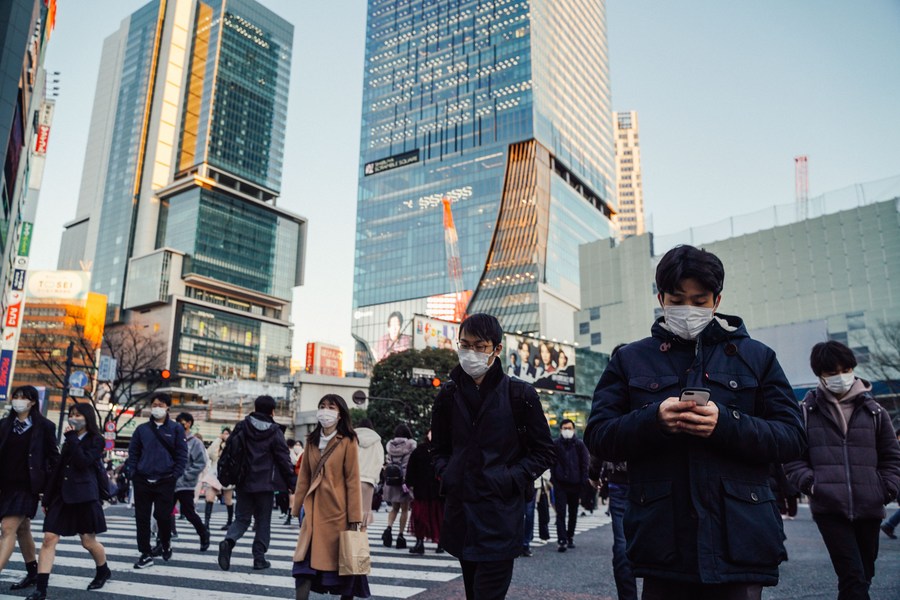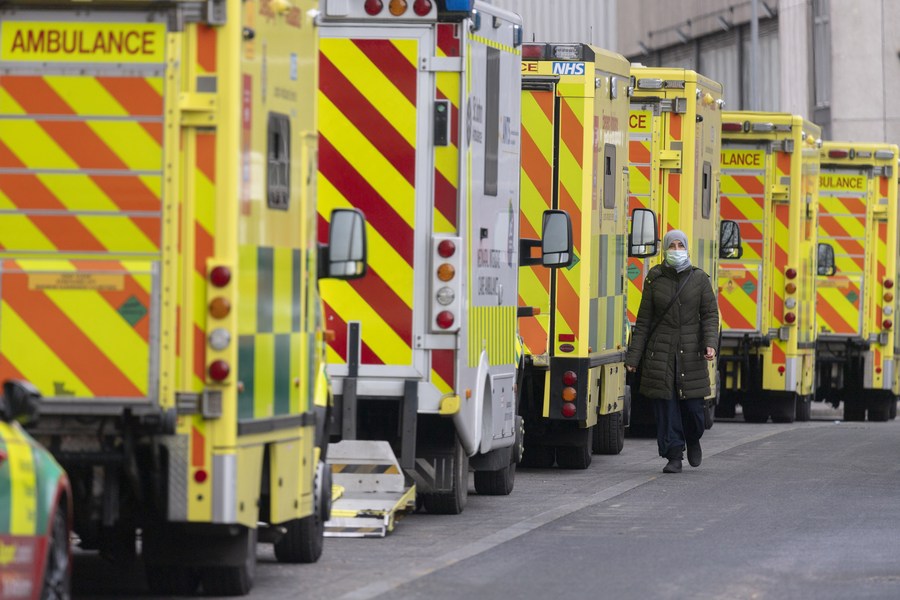"Lying flat" in COVID fight is bane for world
* The world hit a disheartening moment last Saturday as global COVID-19 cases topped 600 million, and death toll more than 6.48 million, showed data from Johns Hopkins University.
* As countries are still wrestling with an ongoing pandemic, health experts alert that the next public health disaster is in the making, and no one has yet had the full knowledge nor test or remedy for it.
* Some governments were either indifferent to rising tallies, sluggish in action or impatient to press on with prudent, restrictive protocols widely believed to be painstaking in the short run.
BEIJING, Sept. 2 (Xinhua) -- The world hit a disheartening moment last Saturday as global COVID-19 cases topped 600 million, and death toll more than 6.48 million, showed data from Johns Hopkins University.
Nearly three years into COVID-19, the pandemic seems nowhere near over, with the globe having passed the tragic milestone of one million reported deaths so far this year.
Despite the severity of constant new waves and soaring number of new cases, some countries have chosen to loosen or even lift COVID-19 restrictions due to gloomy economic outlooks and general fatigue in fighting the virus. However, such lax approach towards the pandemic will pose grave threat to the world, according to experts and analysts.
"We cannot say we are learning to live with COVID-19 when one million people have died with COVID-19 this year alone, when we are two-and-a-half years into the pandemic and have all the tools necessary to prevent these deaths," WHO Director-General Tedros Adhanom Ghebreyesus warned at a recent weekly press briefing.

People wearing face masks walk through the Shibuya scramble crossing in Tokyo, Japan, Jan. 21, 2022. (Xinhua/Zhang Xiaoyu)
ALARMING RESURGENCE
Japan's daily COVID-19-related deaths Thursday surpassed 300 for the third consecutive day, exerting further pressure on the country's medical system overstretched by the seventh wave of infections. The country reported 303 new coronavirus-related deaths over the last 24 hours, pushing the national death toll to 40,258, exceeding 40,000 for the first time. Meanwhile, it logged 149,906 new coronavirus cases, bringing the total number to 19,117,599.
The East Asian country is not the sole victim of a resurgence of COVID-19. According to WHO's COVID-19 Weekly Epidemiological Update, new weekly deaths increased by 183 percent in the African Region and eight percent in the Western Pacific Region during the week of Aug. 15 to 21, 2022.
Though the WHO said the global count of new weekly COVID-19 cases and deaths have decreased steadily for the past few weeks, medical experts feared that the true figures may actually be increasing, as some countries are not properly equipped to thoroughly test their people, and there are also countries that are not carrying out as many tests as before.
WHO's data also showed that one-third of the world's population are still unvaccinated, including two-thirds of health workers and three-quarters of older adults in low-income countries.
The coronavirus remains a "public health emergency of international concern," Tedros noted at a regular weekly press briefing in July, as rising cases are not only putting further pressure on already stretched health systems and workers but also triggering an "increasing trend of deaths."
Much earlier at the World Health Assembly in May, the WHO chief has warned health ministers that it is not time yet for any country to lower its guard, appealing for continued heightened alert to the pandemic, given its uncertain prospects and humanity's waning immunity.
With colder weather approaching in the Northern Hemisphere and people spending more time indoors, the WHO chief warned that the risks for more intense transmission and hospitalization will only increase in the coming months, not only for COVID-19, but for other diseases including influenza.
This was echoed by Professor Lawrence Young, a virologist and a professor of molecular oncology at the University of Warwick. "I do worry that the coronavirus infection will remain serious, particularly for the clinically vulnerable and elderly, for some time to come," he said.
"As we go into the winter months, who knows what will happen. Because we'll have a toxic mix, then we'll have new variants. There will inevitably be other variants that are going to be more transmissible," he added.

A woman puts a flower on the National COVID Memorial Wall in London, Britain, March 27, 2022. (Xinhua/Li Ying)
UNDERESTIMATED IMPACT
As countries are still wrestling with an ongoing pandemic, health experts alert that the next public health disaster is in the making, and no one has yet had the full knowledge nor test or remedy for it.
Reports of people contracting and re-contracting COVID-19 as well as experiencing side effects in one way or another have pointed to the long-term physical fallout of coronavirus infection, largely underestimated, known as "long COVID."
Long COVID is not a single condition but rather "a wide range of new, returning, or ongoing health problems that people experience after first being infected with the virus that causes COVID-19," according to the U.S. Centers for Disease Control and Prevention (CDC).
As of Saturday, the United States had reported 94,184,146 cases and 1,043,838 deaths, both the highest counts among all countries, accounting for nearly 16 percent of the global cases and more than 16 percent of the global deaths, according to data from Johns Hopkins University.
Data collected from June 1 to 13 by the U.S. Census Bureau and analyzed by the National Center for Health Statistics of the CDC showed that more than 40 percent of U.S. adults reported having COVID-19 in the past, and nearly one in five of those are currently still having symptoms of "long COVID."
Overall, one in 13 adults in the United States (7.5 percent) have "long COVID" symptoms, defined as symptoms lasting three or more months after first contracting the virus, and that they didn't have prior to their COVID-19 infection.
People with post-COVID conditions may experience physical and mental health problems of different types and combinations of symptoms happening over different lengths of time, including malaise, fatigue, breathing challenges, cardiovascular abnormalities, migraines, depression and anxiety, among other conditions.
In the United States, for instance, long COVID has been described as the "next national health disaster" and the "pandemic after the pandemic," the Kaiser Family Foundation (KFF), a U.S.-based health research organization, said in a policy watch piece in August.
Moreover, studies indicated that long-COVID side effects are not only wrecking health, but also debilitating the work force and straining the medicare system. And that is probably one of the long-term economic hangovers of the pandemic.
Around 16 million working-age Americans -- those aged 18 to 65 -- have "long COVID" today, according to a report published by the Brookings Institution, a Washington, D.C.-based think tank in August.
Of those, 2-4 million are out of work due to long COVID while the annual cost of those lost wages alone is around 170 billion U.S. dollars a year, and potentially as high as 230 billion dollars, the report showed.
"The pandemic isn't over, but will continue to resonate for months to come," Brookings Institution Senior Fellow Darrell West told Xinhua. "Long COVID will have an impact on the labor force because it will push some people into long-term care issues and keep them out of the workforce. Employers will have to figure out how to handle those cases and ways to pay for their long-term medical needs."

Photo taken on Jan. 28, 2022 shows a woman walking past ambulances parked outside the Royal London Hospital in London, Britain. (Photo by Ray Tang/Xinhua)
BOTCHED RESPONSE
"We're all tired of this virus, and tired of the pandemic. But the virus is not tired of us," WHO chief Tedros said at a recent press briefing. "Learning to live with COVID-19 does not mean we pretend it's not there. It means we use the tools we have to protect ourselves, and protect others."
Some governments were either indifferent to rising tallies, sluggish in action or impatient to press on with prudent, restrictive protocols widely believed to be painstaking in the short run. They are now hastily turning the page when the pandemic is nowhere near the end.
"One of the problems we have in the UK, of course, is all restrictions have been removed and people are assuming, as a consequence, that we're out of the pandemic, and there's been some very mixed messaging from government, including messages that somehow we're in a post pandemic situation when we're clearly not," said Young.
Jonathan Reiner, a cardiologist and professor of medicine and surgery at George Washington University Hospital in the United States, has tweeted "Excuse me, but what's really bullshit is the idea that 3,000 deaths per week, 40,000 people hospitalized at any one time with 5000 in ICUs, is 'scaremongering.' We've had vaccines for 20 months and most of these deaths and severe illnesses were preventable."
In spring the U.S. Congress "rejected a funding package that was meant to get the country ready for fall, arguing that there were still unspent funds. We'll see if this proves extremely shortsighted, or if the U.S. lucks out," Clay Ramsay, a researcher at the Center for International and Security Studies at the University of Maryland, told Xinhua.
"Americans this year have died from COVID at a rate 80 percent higher than Canadians and 30 percent higher than residents of the European Union," Benjamin Mason Meier, a professor of Global Health Policy at the University of North Carolina-Chapel Hill tweeted. "This was a policy failure. It will get worse."
"All countries at all income levels must do more to vaccinate those most at risk, to ensure access to life-saving therapeutics, to continue testing and sequencing, and to set tailored, proportionate policies to limit transmission and save lives," WHO chief Tedros has urged.
He highlighted a disconnect in COVID-19 risk perception between scientific communities, political and the public, describing it as "a dual challenge of communicating risk and building community trust in health tools and public health social measures like masking, distancing and ventilation." (Video reporters: Jiang Xuelan, Xia Lin, Zhang Mocheng, Tan Jingjing; video editors: Luo Hui, Zhu Jianhui, Wang Houyuan)
Photos
Related Stories
- Chinese researchers develop anti-SARS-CoV-2 nanomaterial
- New study suggests SARS-CoV-2 antigen levels linked to patient outcomes
- Chinese mainland reports 553 new local confirmed COVID-19 cases
- Daily COVID-19 cases across 17 provincial-level regions surpass 2,000
- Japan's daily COVID-19 cases hit record high of 250,403
- Four more cities in Hainan in ‘static management’ as 1,140 COVID-19 cases reported in a week
- Chinese mainland reports 106 new local confirmed COVID-19 cases
- Chinese mainland reports 47 new local confirmed COVID-19 cases
- EMA sees new COVID-19 wave in many EU countries
- Hospital system under stress as Aussie state on verge of new wave of COVID-19
Copyright © 2022 People's Daily Online. All Rights Reserved.









